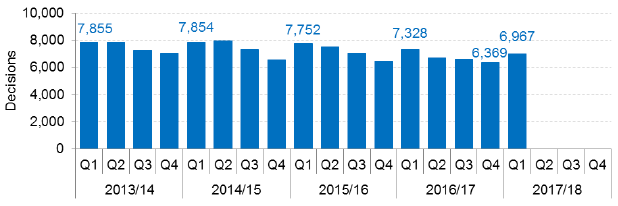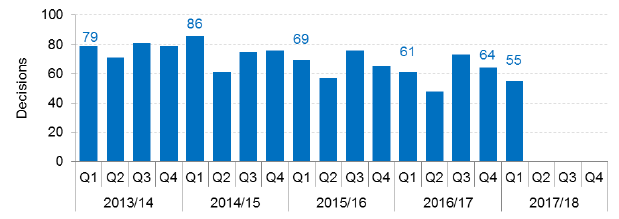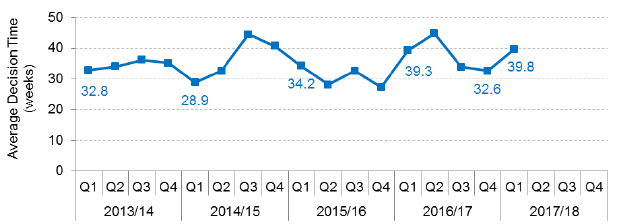Planning performance statistics: first quarter, 2017-2018
The latest statistics on planning application decision-making and timescales for quarter 1 of 2017 and data going back to quarter one of 2013-2014.
Planning Performance Statistics, 2017/18, Q1
This report presents the latest summary statistics on planning application decision-making and timescales for April to June 2017 (Quarter 1), as well as historic data going back to quarter one of 2013/14. It is based on data collected by the Scottish Government from Local and Planning Authorities as part of the Planning Performance Framework (introduced in 2012).
Applications for Local Developments (excludes legacy cases)
There were 6,967 applications for local developments decided in quarter one of 2017/18, 598 (9 per cent) more than the 6,369 decisions in the previous quarter, and 361 (5 per cent) fewer applications than the 7,328 decisions in quarter one of 2016/17. The average decision time for these 6,967 local developments was 8.8 weeks, quicker by almost four days compared to the previous quarter (9.3 weeks), and the quickest for any quarter since the start of the data collection in 2012/13.
Chart 1: Applications for Local Developments: Number of decisions

Chart 2: Applications for Local Developments: Average decision time (weeks)

Some of the changes over time seen in the decision times may be partly due to improvements in recording of periods of inaction by the applicant. This is referred to as “stopping the clock”. See Section 9 for further details.
In addition, there were 379 local development applications concluded in quarter one of 2017/18 that were subject to separate processing agreements and are not included in average time calculations. 81.5 per cent of these applications met the agreed timescales that had been set between developers and local authorities.
These figures exclude two pre 3rd August 2009 legacy cases. Further details about legacy cases can be seen in Section 10.
Applications for Major Developments (excludes legacy cases)
For applications subject to average time calculations there were 55 major developments decided in quarter one of 2017/18, 9 (14 per cent) fewer than the 64 decisions in the previous quarter, and 6 (10 per cent) fewer than the 61 decisions in the equivalent quarter of 2016/17. The average decision time for these 55 major developments was 39.8 weeks, more than seven weeks slower than the previous quarter (32.6 weeks) and slower by a half week compared to the equivalent quarter one figure (39.3 weeks) in 2016/17.
Chart 3: Applications for Major Developments: Number of decisions

Chart 4: Applications for Major Developments: Average decision time (weeks)

The average time figure of 39.8 weeks has been influenced by a number of lengthier decision times, including five decision times that each took longer than two years.
Further information on the distribution of decision times for major development applications is given in Annex A.
Some of the changes over time seen in the decision times may be partly due to improvements in recording of periods of inaction by the applicant. This is referred to as “stopping the clock”. See Section 9 for further details.
In addition there were a further 26 major development applications concluded in quarter one of 2017/18 that were subject to separate processing agreements. 69.2 per cent of these applications met agreed timescales that had been set between developers and local authorities. Applications subject to processing agreements are not included in average time calculations. For the most recent quarter, major applications with processing agreements accounted for a third of the decisions made for all major developments. When processing agreements are included there is an overall decrease of 7 per cent in the total number of decisions made for major applications from 87 in quarter four of 2016/17 to 81 in quarter one of 2017/18.
These figures exclude one pre 3rd August 2009 legacy case. Further details about legacy cases can be seen in Section 10.
Contact
There is a problem
Thanks for your feedback